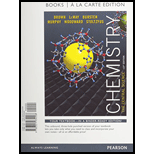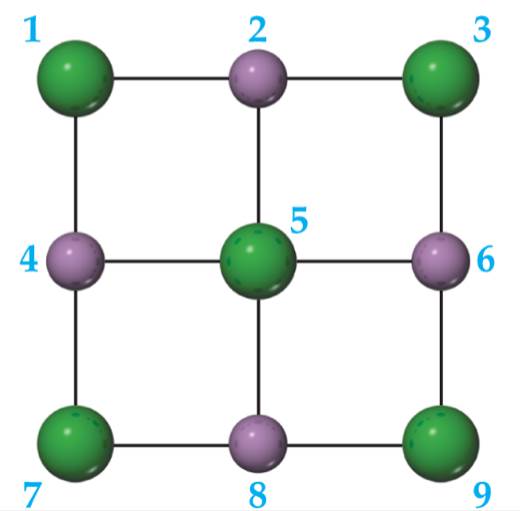
Chemistry: The Central Science, Books a la Carte Edition & Modified Mastering Chemistry with Pearson eText -- ValuePack Access Card Package
1st Edition
ISBN: 9780133910919
Author: Theodore E. Brown, H. Eugene LeMay, Bruce E. Bursten, Catherine Murphy, Patrick Woodward, Matthew E. Stoltzfus
Publisher: PEARSON
expand_more
expand_more
format_list_bulleted
Concept explainers
Textbook Question
Chapter 16, Problem 42E
A portion of a two-dimensional "slab" of NaCl(s) is shown here (see Figure 8.2) in which the ions are numbered.
- Which colored balls must represent sodium ions?
- Which colored balls must represent chloride ions?
- Consider ion 5. How many attractive electrostatic interactions are shown for it?
- Consider ion 5. How many repulsive interactions are shown for it?
- Is the sum of the attractive interactions in part (c) larger or smaller than the sum of the repulsive interactions in part (d)?
- If this pattern of ions was extended indefinitely in two dimensions, would the lattice energy be positive or negative? [Section 8.2]

Expert Solution & Answer
Want to see the full answer?
Check out a sample textbook solution
Students have asked these similar questions
An essential part of the experimental design process is to select appropriate dependent and
independent variables.
True
False
10.00 g of Compound X with molecular formula C₂Hg are burned in a constant-pressure calorimeter containing 40.00 kg of water at 25 °C. The temperature of
the water is observed to rise by 2.604 °C. (You may assume all the heat released by the reaction is absorbed by the water, and none by the calorimeter itself.)
Calculate the standard heat of formation of Compound X at 25 °C.
Be sure your answer has a unit symbol, if necessary, and round it to the correct number of significant digits.
need help not sure what am doing wrong step by step please answer is 971A
During the lecture, we calculated the Debye length at physiological salt concentrations and temperature, i.e. at an ionic strength of 150 mM (i.e. 0.150 mol/l) and a temperature of T=310 K. We predicted that electrostatic interactions are effectively screened beyond distances of 8.1 Å in solutions with a physiological salt concentration.
What is the Debye length in a sample of distilled water with an ionic strength of 10.0 µM (i.e. 1.00 * 10-5 mol/l)? Assume room temperature, i.e. T= 298 K, and provide your answer as a numerical expression with 3 significant figures in Å (1 Å = 10-10 m).
Chapter 16 Solutions
Chemistry: The Central Science, Books a la Carte Edition & Modified Mastering Chemistry with Pearson eText -- ValuePack Access Card Package
Ch. 16.2 - Consider the following equation: Ca + (g) + e-...Ch. 16.2 -
7.55(a) Does metallic character increase,...Ch. 16.2 - Prob. 16.2.1PECh. 16.2 - Predict whether each of the following oxides is...Ch. 16.2 - Prob. 16.3.1PECh. 16.2 - Would you expect manganese(II) oxide, MnO, react...Ch. 16.3 - Prob. 16.4.1PECh. 16.3 - Prob. 16.4.2PECh. 16.3 - An element X reacts with oxygen to form X02 and...Ch. 16.3 - Prob. 16.5.2PE
Ch. 16.4 - Prob. 16.6.1PECh. 16.4 - Prob. 16.6.2PECh. 16.4 - Prob. 16.7.1PECh. 16.4 - Prob. 16.7.2PECh. 16.5 - Write a balanced equation for the reaction that...Ch. 16.5 - (a) As described in Section 7.7 , the alkali...Ch. 16.5 - Prob. 16.9.1PECh. 16.5 - Prob. 16.9.2PECh. 16.6 - Arrange each of the following sets of atoms and...Ch. 16.6 - Prob. 16.10.2PECh. 16.6 - In the ionic compoundsLiF,NaCI,KBr, andRbl, the...Ch. 16.6 - Prob. 16.11.2PECh. 16.6 -
7.38 Write equations that show the process for...Ch. 16.6 - Prob. 16.12.2PECh. 16.6 - Prob. 16.13.1PECh. 16.6 - Prob. 16.13.2PECh. 16.6 - (a) What is the trend in first ionization energies...Ch. 16.6 - Prob. 16.14.2PECh. 16.7 - Prob. 16.15.1PECh. 16.7 - Prob. 16.15.2PECh. 16.7 - Prob. 16.16.1PECh. 16.7 - Prob. 16.16.2PECh. 16.8 - Prob. 16.17.1PECh. 16.8 - Write an equation for the second electron affinity...Ch. 16.9 - If the electron affinity for an element is a...Ch. 16.9 - Prob. 16.18.2PECh. 16.9 -
7.52 What is the relationship between the...Ch. 16.9 - Prob. 16.19.2PECh. 16.10 - Prob. 16.20.1PECh. 16.10 - Prob. 16.20.2PECh. 16 - Mercury in the environment can exist in oxidation...Ch. 16 - When magnesium metal is burned in air (Figure 3.6...Ch. 16 - The dipole moment of chlorine monofluoride,...Ch. 16 - Prob. 3ECh. 16 - Consider the element silicon, Si. Write its...Ch. 16 - Prob. 5ECh. 16 - Prob. 6ECh. 16 - Prob. 7ECh. 16 - Prob. 8ECh. 16 - Prob. 9ECh. 16 - Prob. 10ECh. 16 - Prob. 11ECh. 16 - Prob. 12ECh. 16 - Prob. 13ECh. 16 - Prob. 14ECh. 16 - Prob. 15ECh. 16 - Prob. 16ECh. 16 - Prob. 17ECh. 16 - Prob. 18ECh. 16 - Prob. 19ECh. 16 - Prob. 20ECh. 16 - Which of the these elements is most likely to from...Ch. 16 - Prob. 22ECh. 16 - Which of the following bond is the most polar? H-F...Ch. 16 - Prob. 24ECh. 16 - Prob. 25ECh. 16 - Prob. 26ECh. 16 - Which of the following bonds is the most polar? a....Ch. 16 - Which of the following bonds is most polar: S-Cl,...Ch. 16 - Prob. 29ECh. 16 -
How many valence electrons should appear in the...Ch. 16 - Compare the lewis symbol for neon the structure...Ch. 16 - Prob. 32ECh. 16 - Prob. 33ECh. 16 - Prob. 34ECh. 16 - Prob. 35ECh. 16 - Prob. 36ECh. 16 - Which of the statements about resonance is true?...Ch. 16 - Prob. 38ECh. 16 - Prob. 39ECh. 16 - Prob. 40ECh. 16 - Prob. 41ECh. 16 - A portion of a two-dimensional "slab" of NaCl(s)...Ch. 16 - Prob. 43ECh. 16 - Prob. 44ECh. 16 - Incomplete Lewis structures for the nitrous acid...Ch. 16 - Prob. 46ECh. 16 - Prob. 47ECh. 16 - Prob. 48ECh. 16 - True or false: The hydrogen atom is most stable...Ch. 16 - Prob. 50ECh. 16 - What is the Lewis symbol for each of the following...Ch. 16 - Using Lewis symbols, diagram the reaction between...Ch. 16 - Use Lewis symbols to represent the reaction that...Ch. 16 - Predict the chemical formula of the ionic compound...Ch. 16 - Prob. 55ECh. 16 - Prob. 56ECh. 16 - Prob. 57ECh. 16 - Is lattice energy usually endothermic or...Ch. 16 - NaCI and KF have the same crystal structure. The...Ch. 16 - Consider the ionic compounds KF, NaCl, NaBr, and...Ch. 16 - Which of the following trends in lattice energy is...Ch. 16 - Energy is required to remove two electrons from Ca...Ch. 16 - Prob. 63ECh. 16 - Use data from Appendix C, Figure 7.10, and Figure...Ch. 16 - Prob. 65ECh. 16 - Prob. 66ECh. 16 - Prob. 67ECh. 16 - Using Lewis symbols and Lewis structures, diagram...Ch. 16 - Use Lewis symbols and Lewis structures to diagram...Ch. 16 - Prob. 70ECh. 16 - What is the trend in electronegativity going from...Ch. 16 - Prob. 72ECh. 16 - By referring only to the periodic table, select...Ch. 16 - which of the following bonds are polar? B-F,...Ch. 16 - Prob. 75ECh. 16 - Prob. 76ECh. 16 - Prob. 77ECh. 16 - In the following pairs of binary compounds,...Ch. 16 - Prob. 79ECh. 16 - Prob. 80ECh. 16 - Draw the dominant Lewis structure for the...Ch. 16 - Prob. 82ECh. 16 - Prob. 83ECh. 16 - Prob. 84ECh. 16 - Prob. 85ECh. 16 - Prob. 86ECh. 16 - Prob. 87ECh. 16 - Prob. 88ECh. 16 - Prob. 89ECh. 16 - Prob. 90ECh. 16 - 8.62 For Group 3A-7A elements in the third row of...Ch. 16 - Draw the Lewis structures for each of the...Ch. 16 - Prob. 93ECh. 16 - Prob. 94ECh. 16 -
8.66
Describe the molecule xenon trioxide, XeO3,...Ch. 16 -
8.67 There are many Lewis structures you could...Ch. 16 - Prob. 97ECh. 16 - Using Table 8.3, estimate H for each of the...Ch. 16 - Using Table 8.3, estimate H for the following...Ch. 16 - Prob. 100AECh. 16 - Prob. 101AECh. 16 - Prob. 102AECh. 16 - Prob. 103AECh. 16 - Consider the stable elements through lead (Z =...Ch. 16 -
17.80]Figure 7.4 shows the radial probability...Ch. 16 - (a) If the core electrons were totally effective...Ch. 16 - Prob. 107AECh. 16 - Prob. 108AECh. 16 - Prob. 109AECh. 16 - The following observations are made about two...Ch. 16 - Prob. 111AECh. 16 - Prob. 112AECh. 16 - Prob. 113AECh. 16 - Prob. 114AECh. 16 - Prob. 115AECh. 16 - Prob. 116IECh. 16 - Prob. 117IECh. 16 - Prob. 118IECh. 16 - Prob. 119IECh. 16 - Prob. 120IECh. 16 - The electron affinities. in kJ/mol, for the group...Ch. 16 -
7.99 Hydrogen is an unusual element because it...Ch. 16 - Prob. 123IECh. 16 - Prob. 124IECh. 16 - Which of the following is the expected product of...Ch. 16 - Elemental cesium reacts more violently with water...
Knowledge Booster
Learn more about
Need a deep-dive on the concept behind this application? Look no further. Learn more about this topic, chemistry and related others by exploring similar questions and additional content below.Similar questions
- Influence of salt concentrations on electrostatic interactions 2 Answer is 2.17A why not sure step by step please What is the Debye length in a concentrated salt solution with an ionic strength of 2.00 mol/l? Assume room temperature, i.e. T= 298 K, and provide your answer as a numerical expression with 3 significant figures in Å (1 Å = 10-10 m).arrow_forwardThe name of the following molecule is: Νarrow_forwardThe table shows the tensile stress-strain values obtained for various hypothetical metals. Based on this, indicate which is the most brittle and which is the most tough (or most resistant). Breaking strength Elastic modulus Material Yield strength Tensile strength Breaking strain A (MPa) 415 (MPa) (MPa) (GPa) 550 0.15 500 310 B 700 850 0.15 720 300 C Non-effluence fracture 650 350arrow_forward
- Please correct answer and don't used hand raitingarrow_forwardThe table shows the tensile stress-strain values obtained for various hypothetical metals. Based on this, indicate which material will be the most ductile and which the most brittle. Material Yield strength Tensile strength Breaking strain Breaking strength Elastic modulus (MPa) (MPa) (MPa) (GPa) A 310 340 0.23 265 210 B 100 120 0.40 105 150 с 415 550 0.15 500 310 D 700 850 0.14 720 210 E - Non-effluence fracture 650 350arrow_forwardPlease correct answer and don't used hand raitingarrow_forward
arrow_back_ios
SEE MORE QUESTIONS
arrow_forward_ios
Recommended textbooks for you
 Chemistry by OpenStax (2015-05-04)ChemistryISBN:9781938168390Author:Klaus Theopold, Richard H Langley, Paul Flowers, William R. Robinson, Mark BlaserPublisher:OpenStax
Chemistry by OpenStax (2015-05-04)ChemistryISBN:9781938168390Author:Klaus Theopold, Richard H Langley, Paul Flowers, William R. Robinson, Mark BlaserPublisher:OpenStax Chemistry: Principles and PracticeChemistryISBN:9780534420123Author:Daniel L. Reger, Scott R. Goode, David W. Ball, Edward MercerPublisher:Cengage Learning
Chemistry: Principles and PracticeChemistryISBN:9780534420123Author:Daniel L. Reger, Scott R. Goode, David W. Ball, Edward MercerPublisher:Cengage Learning Introductory Chemistry: A FoundationChemistryISBN:9781337399425Author:Steven S. Zumdahl, Donald J. DeCostePublisher:Cengage Learning
Introductory Chemistry: A FoundationChemistryISBN:9781337399425Author:Steven S. Zumdahl, Donald J. DeCostePublisher:Cengage Learning Chemistry for Engineering StudentsChemistryISBN:9781337398909Author:Lawrence S. Brown, Tom HolmePublisher:Cengage Learning
Chemistry for Engineering StudentsChemistryISBN:9781337398909Author:Lawrence S. Brown, Tom HolmePublisher:Cengage Learning Chemistry: The Molecular ScienceChemistryISBN:9781285199047Author:John W. Moore, Conrad L. StanitskiPublisher:Cengage Learning
Chemistry: The Molecular ScienceChemistryISBN:9781285199047Author:John W. Moore, Conrad L. StanitskiPublisher:Cengage Learning

Chemistry by OpenStax (2015-05-04)
Chemistry
ISBN:9781938168390
Author:Klaus Theopold, Richard H Langley, Paul Flowers, William R. Robinson, Mark Blaser
Publisher:OpenStax

Chemistry: Principles and Practice
Chemistry
ISBN:9780534420123
Author:Daniel L. Reger, Scott R. Goode, David W. Ball, Edward Mercer
Publisher:Cengage Learning

Introductory Chemistry: A Foundation
Chemistry
ISBN:9781337399425
Author:Steven S. Zumdahl, Donald J. DeCoste
Publisher:Cengage Learning

Chemistry for Engineering Students
Chemistry
ISBN:9781337398909
Author:Lawrence S. Brown, Tom Holme
Publisher:Cengage Learning

Chemistry: The Molecular Science
Chemistry
ISBN:9781285199047
Author:John W. Moore, Conrad L. Stanitski
Publisher:Cengage Learning
Types of bonds; Author: Edspira;https://www.youtube.com/watch?v=Jj0V01Arebk;License: Standard YouTube License, CC-BY